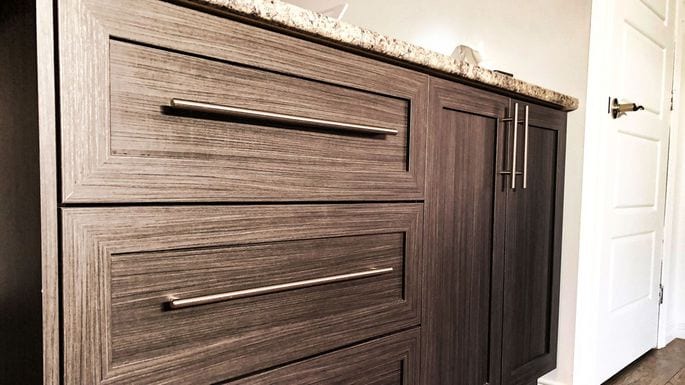One of the hardest choices you’ll have to make during a kitchen remodel is what kind of cabinets to get. After all, this is where all your dishes and more get stored, so whatever you choose must suit your needs and tastes, and fit the space and your budget.
In this latest installment of our Dream Kitchen Remodeling Guide, we’ll lay out all your options, as well as the pros, cons, and costs. Here’s what to consider in order to identify the right kitchen cabinets for you.
Off the shelf or custom-made?
Cabinets come in three different categories. Which one you go with will largely depend on how much space you have, as well as your budget
1. Stock cabinets: You can buy these cabinets right off the shelf at a big-box store such as Ikea.
- Cost: $60 to $200 per linear foot
- Pros: Theyre the value-minded choice, says Nancy Vayo, senior interior design leader for Ikea North America.
- Cons: If you have an unusually sized space, you might not find stock cabinets that fit. Your options for color, hardware, and accessories will be limited, too.
2. Semicustom cabinets: These cabinets are a slightly pricier, hybrid option. You get to add some custom details—such as style, finish, and specific measurements—to stock cabinets.
- Cost: $100 to $650 per linear foot
- Pros: You’ll have more say over the final product than you would with stock cabinets. (And without breaking the bank.)
- Cons: Your options, including what materials your cabinets are made from, will still be restricted.
3. Custom cabinets: Color, material, and size are all in your control.
- Cost: $500 to $1,200 per linear foot
- Pros: Custom-made cabinets will fit your kitchen and specifications exactly. Think of them like a bespoke suit compared with one you buy off the rack
- Con: Cha-ching. Theyre the priciest cabinet optionespecially if theyre made from solid wood.
Want the cheapest option of all? Keep the cabinets you already have and replace the doors for a new look at a very low cost.
Types of cabinets
“Take a serious inventory of what is used and where it is to be located and stored for optimal functionality,” says Ana Cummings of ANA Interiors, an interior design and decorating firm. “You can house practically anything, from the smallest piece of cutlery to the largest stock pot.”
That info (and the physical space you’re working in) will help you decide on the type of cabinets you need. Here are the main options.
Base cabinet
A standard base cabinet measures 24 inches deep and 36 inches tall. For convenience, this type of cabinet comes on a recessed riser called a toe kick, which leaves room for your feet to slide in while you’re prepping food up top.
“Drawers on base cabinets offer a more user-friendly solution as you can pull them out and look inside; no more getting on your hands and knees and rummaging around in the back of a dark cabinet to find the colander,” says Vayo.
Yet, base corners are often difficult spots to get the maximum use of space. If you go this route, choose a corner cabinet with a carousel inside.
“It will not only enhance the storage capacity but also provide an easy-to-access solution for larger kitchen accessories like heavy stockpots,” says Vayo.
Wall cabinets
Upper cabinets are excellent for storing both food and kitchen gear. Bonus: You can choose your own height. A wall cabinet can reach all the way to the ceiling or as high up as you need.
Tall cabinets
Think pantry or broom closet—these skinny cabinets are the perfect shape to store tall items or when you want to make the most of a narrow area. A typical height is around 84 inches.
Open shelving
“Open shelving makes items easier to access, and it can be efficient not having to open and close doors and for small spaces,” says Stephanie Pierce, director of designs and trends at MasterBrand Cabinets.
While these shelves themselves may not be pricey, the brackets can be. And beware: “Many people cite the concern of dust or animal hair landing on their dishes,” says Pierce.
What about cabinet hardware?
Drawers, handles, pulls, and knobs are purely aesthetic choices, says Vayo. Keep them as simple as you like or make your hardware a full-on accent.
Knobs and handles can be used together, depending on the door or drawer being opened.
“Wider drawers work better with handles, while narrow drawers can often be outfitted with a matching knob,” explains Vayo.
For a more modern style, “knob- and handle-free is another option,” Vayo says. These have push latches, and a simple press to the corner of the door opens it.
With an electric push opener, a slight push and your doors and drawers will open and close automatically—especially helpful when your hands are full and you need quick access to the trash can.
If you feel decision fatigue coming on, tap into the expertise of a designer, whether in-store or one you privately hire. With the help of a pro, you can land on a cabinet style that suits your needs, fits your home, maximizes your budget, and perfectly houses every cumbersome kitchen object you own.
- 10 Things Your Competitors Can Teach You About Real Estate
- Why You Shouldn’t Take Your House Off the Market During the Holidays
- Existing Home Sales Surge Through The Holidays
- Homeowner’s Net Worth Is 45x Greater Than A Renter’s
- Top 5 Reasons You Should Not For Sale By Owner
- How To Prepare Your Home For Hurricane Season
- How Homeowners Celebrate This Hot, New Trend
- Time to File Florida Homestead Exemption!
- 6 Seemingly Innocent Habits That Are Hurting Your Health
- Are You Getting the Home Tax Deductions You’re Entitled To?
- What Would a Millennial Baby Boom Mean for Housing?
- 8 Questions to Ask Yourself to Help You Declutter
- Stop making excuses and clean up the clutter in your home!
- 5 Things Your Home Appraiser Wishes You Knew
- Are You 1 of the 59 Million Planning to Buy This Year?
- 3 Questions to Ask If You Want to Buy Your Dream Home
- The Truth About Homeowner Equity
- Schedule for Fertilizing Lawns
- Have You Saved Enough for Closing Costs?
- Why Pre-Approval Should Be Your First Step
- 100% COMMISSION FOR REALTORS
- 6 Plants and Shrubs That’ll Wreck Your Yard and Ruin Your Life
- How to Price a Home in a Seller’s Market: Go Low, or High?











